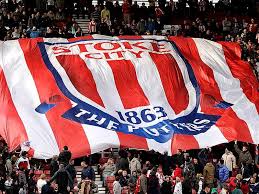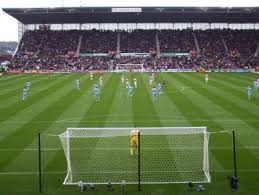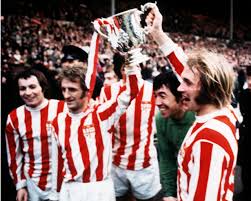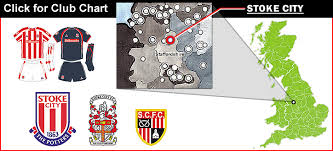 |  |  |  |
English Premier League
England
The Barclays English Premier League (EPL), considered as the best in the world.
Aston Villa vs Stoke City
Official name Aston Villa FC
City Birmingham
Founded 1874
Club colors Red-light Blue / White / Light Blue
vs.
0 - 0
Stoke City
Official name Stoke City FC
City Stoke-on-Trent
Founded 1868
Club colors Red-White / White / White
Match scheduled:
Date: 19-12-2009
Time:15:00 until 17:00
Week 18 / Round 18 :: Barclays Premier League 2009/2010
Aston Villa's current home venue is Villa Park, which is a UEFA 4-star rated stadium, having previously played at Aston Park (1874–1876) and Perry Barr (1876–1897). Villa Park is the largest football stadium in the English Midlands, and the eighth largest stadium in England. It has hosted 16 England internationals at senior level, the first in 1899, and the most recent in 2005. Thus it was the first English ground to stage international football in three different centuries.[32]
Villa Park is the most used stadium in FA Cup semi-final history, having hosted 55 semi-finals. The Club have planning permission to extend the North Stand; This will involve the 'filling in' of the corners to either side of the North Stand. If completed, the capacity of Villa Park will be increased to approximately 51,000. The current training ground is located at Bodymoor Heath in north Warwickshire, the site for which was purchased by former Aston Villa Chairman Doug Ellis in the early 1970s from a local farmer. Although Bodymoor Heath was state-of-the-art in the 1970s, by the late 1990s the facilities had started to look dated. In November 2005, Ellis and Aston Villa plc announced a state of the art GB£13 million redevelopment of Bodymoor in 2 phases. However, work on Bodymoor was suspended by Ellis due to financial problems, and was left in an unfinished state until new owner Randy Lerner made it one of his priorities to make the site one of the best in world football. The new training ground was officially unveiled on 6 May 2007, by current manager Martin O'Neill, then team captain Gareth Barry and 1982 European Cup winning team captain Dennis Mortimer, with the Aston Villa squad moving in for the 2007–08 season.[33]
Mercer's forced retirement from the club in 1964 signaled a period of deep turmoil. The most successful club in England was struggling to keep pace with changes in the modern game, with Villa being relegated for the third time, under manager Dick Taylor in 1967. The following season the fans called for the board to resign as Villa finished 16th in the Second Division. With mounting debts and Villa lying at the bottom of Division Two, the board sacked Cummings (the manager brought in to replace Taylor), and within weeks the entire board resigned under overwhelming pressure from fans.[20] After much speculation, control of the club was bought by London financier Pat Matthews, who also brought in Doug Ellis as chairman.[20] However, new ownership could not prevent Villa being relegated to the Third Division for the first time at the end of the 1969–70 season. However, Villa gradually began to recover under the management of former club captain Vic Crowe. In the 1971–72 season they returned to the Second Division as Champions with a record 70 points.[21] In 1974 Ron Saunders was appointed manager. His brand of no-nonsense man-management proved effective, with the club winning the League Cup the following season. By 1977 he had taken them back into the First Division and Europe.[22]
Villa were back amongst the elite as Saunders continued to mould a winning team. This culminated in a seventh top-flight league title in 1980–81. To the surprise of commentators and fans, Saunders quit halfway through the 1981–82 season, after falling out with the chairman, with Villa in the quarter final of the European Cup. He was replaced by his softly-spoken assistant manager Tony Barton who guided the club to a 1–0 victory over Bayern Munich in the European Cup final in Rotterdam courtesy of a Peter Withe goal. The following season Villa were crowned European Super Cup winners, beating Barcelona in the final. This marked a pinnacle though and Villa's fortunes declined sharply for most of the 1980s, culminating in relegation in 1987.[23] This was followed by promotion the following year under Graham Taylor and a runners-up position in the First Division in the 1989-90 season.[24]
Villa were one of the founding members of the Premier League in 1992, and finished runners-up to Manchester United in the inaugural season. For the rest of the Nineties however Villa went through three different managers and their league positions were inconsistent, although they did win two League Cups and regularly achieved Uefa Cup qualification. Villa reached the FA Cup final in 2000 but lost 1–0 to Chelsea in the last game to be played at the old Wembley Stadium.[5] Again Villa's league position continued to fluctuate under several different managers and things came to a head in the summer of 2006 when David O'Leary left in acrimony.[25] After 23 years as chairman and single biggest shareholder (approximately 38%), Doug Ellis finally decided to sell his stake in Aston Villa due to ill-health. After much speculation it was announced the club was to be bought by American Businessman Randy Lerner, owner of NFL franchise the Cleveland Browns.[26] The arrival of a new owner and manager Martin O'Neill marked the start of a new period of optimism at Villa Park and sweeping changes occurred throughout the club including a new crest, a new kit sponsor and team changes in the summer of 2007.[9][27]

Stoke City F.C., considered to be the second-oldest English football league club, formed in 1863, under the name Stoke Ramblers, when pupils of Charterhouse School formed a football club while apprentices at the North Staffordshire Railway works in Stoke-on-Trent.[1] The club's first documented match was five years later, in October 1868, against an EW May XV at the Victoria Cricket Club ground. Henry Almond, the club's founder, was also captain, and scored the club's first ever goal. During this period they played at the Victoria Cricket Ground; however, they switched to a nearby ground at Sweetings Field in 1875 to cope with rising attendances.[1]

In 1878, the club merged with Stoke Victoria Cricket Club, and became Stoke Football Club.[1] They moved from their previous ground, Sweetings Field, to the Athletic Club ground, which soon became known as the Victoria Ground.[2] It was around this time that the club adopted their traditional red-and-white striped kit. In August 1885, the club turned professional.[1]
Stoke was one of the twelve founding members of The Football League when it was introduced in 1888.[3] The club struggled in their first two seasons, 1888-89 and 1889-90, finishing bottom on both occasions.[4] In 1914, the First World War meant the league was suspended for four years, until it eventually recommenced in August 1919. During this wartime period, Stoke entered the Lancashire Primary and Secondary leagues.[5]
 |  |  |  |









